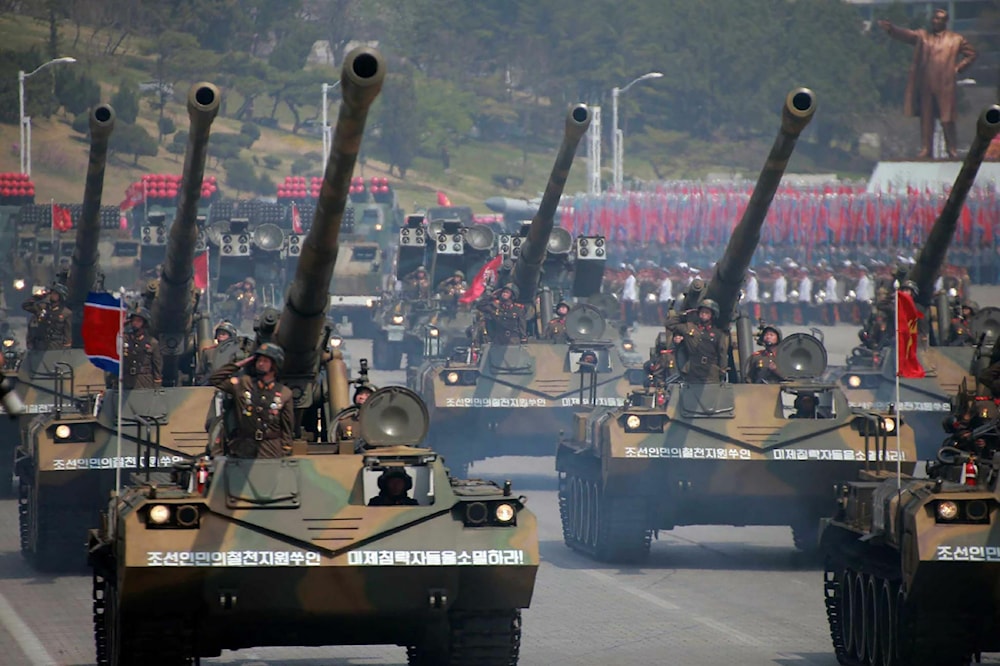DPRK shells maritime border; South Korea orders evacuation
The South Korean military has ordered citizens on Yeonpyeong Island to evacuate following the DPRK's "provocations".
-

The Korean People's howitzers parade in the Democratic People's Republic of Korea's capital, Pyongyang, on April 16, 2017. (KCNA)
South Korea has ordered its citizens in Yeonpyeong Island, which is also recognized as Yŏnphyŏng Islet by the Democratic People's Republic of Korea (DPRK), to head to shelters on Friday amid "signs of a military provocation" by the DPRK, according to the South Korean news agency Yonhap.
Citing local officials, the news agency said an emergency evacuation order was issued at 12:02 pm (local time) and was repeated again less than 30 minutes later at the request of the South Korean military.
"We announced the evacuation after receiving a call from a military unit saying it was carrying out a maritime strike on Yeongpyeong Island as it has a situation with a North Korean provocation," the official was quoted as saying.
The Island is among a group of Korean islands located in the Yellow Sea 12km from the DPRK's Hwanghae Province and holds a small population of a few thousand.
Earlier on Friday, the news agency reported that the DPRK's military fired 200 artillery shells into waters off its western coast in the vicinity of the Island group. The South Korean Joint Chiefs of Staff (JCC) alleged that shells were fired at 9:00 am local time until 11:00 am from Jangsan Cape, north of South Korea's northernmost Island of Baengnyeong, and Deungsan Cape, north of the South's western border island of Yeonpyeong.
Reportedly, the shells landed in the maritime buffer zone north of the Northern Limit Line, the maritime border listed under the inter-Korean military accord (CMA) signed in 2018. No casualties were reported as a result of the incident.
This comes as Kim Jong Un and his “probable successor” Ju Ae visited an intercontinental ballistic missile (ICBM) mobile launcher vehicle factory, a move seen by an expert that signals a strong commitment to ramp up the production of these vehicles.
DPRK's leader Kim Jong Un “conducted an on-site guidance at an important military vehicle production factory,” state-run Korean Central News Agency said Friday.
Kim, accompanied by major ruling party officials including the powerful sister Kim Yo Jong, observed “various military vehicles produced at the factory, gaining a detailed understanding of their production status,” KCNA added.
Photos released by KCNA showed the DPRK leadership standing before mobile launch vehicles, which could be equipped to launch its latest ICBM, the Hwasong-18.
Read more: DPRK to launch three more reconnaissance satellites in 2024: KCNA
No unification by absorption
It is worth noting that the DPRK's Ministry of Defense announced earlier in November last year that it has officially withdrawn from the military agreement. The statement issued by Pyongyang emphasized that as a consequence of this withdrawal, the DPRK would be fortifying its border with South Korea, indicating an intent to resume all military measures that were previously halted under the CMA.
In this context, DPRK leader Kim Jong Un acknowledged the impossibility of forging a partnership with South Korea and directed the reorganization of all work plans involving Seoul and relevant entities in light of the current circumstances.
Kim conveyed this message during the plenary session of the Korean Workers' Party Central Committee, which took place from December 26 to December 30.
In his closing speech on "The Orientation of Struggle in 2024," he said, "The general conclusion drawn by our Party, looking back upon the longstanding north-south relations is that reunification can never be achieved with the ROK [South Korean] authorities that defined the 'unification by absorption' and 'unification under liberal democracy' as their state policy, which is in sharp contradiction with our line of national reunification based on one nation and one state with two systems... The reality urgently calls for us to adopt a new approach to north-south relations and the reunification policy."
Read more: DPRK warns of 'grave action without hesitation' against US hostilities

 4 Min Read
4 Min Read










